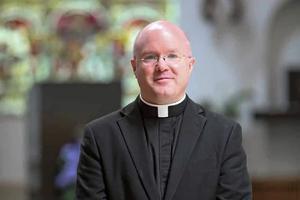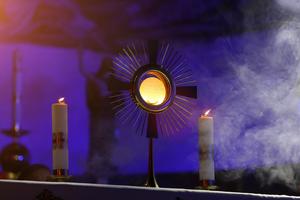Notre Dame’s Burnt Sacrifice: A Reminder God Is With Us
COMMENTARY: The response to the devastating fire in Paris should inform the rebuilding project in each of us and in all of us together, made by baptism true temples of God.

Except among the devout who live Holy Week as a sacred octave, Monday of Holy Week is normally low-key, a day seemingly like any other, when many believers and nonbelievers succumb to the practical atheism of living as if God were absent.
Not this year.
When Notre Dame Cathedral in Paris, Christianity’s second-most famous church, was ablaze and risked being reduced to ashes, it was impossible to forget God. Many across the world stopped and turned sad eyes toward the live images coming from the banks of the Seine. Believers and nonbelievers prayed that, by some miracle, the water would outpace the flames and the munificent 859-year-old sanctuary would see an 860th year.
Those who had visited Notre Dame and been touched by its soaring beauty were sentimental, grateful for their past visits but feeling profound emptiness that they might never have that experience again. Those who had never visited perhaps felt the impending loss even more.
Notre Dame was called by Pope Benedict in 2008 a “living sign of God’s presence in our midst.” It was a vivid witness to the faith and love for God, combined with more than a century of hard work and ingenuity, that built it. Visited by 13 million people a year, it was a place where, across the centuries, saints and sinners convened, as they were introduced into a universe far more expansive than the French Gothic shrine’s physical dimensions.
It seemed that this living sign was engaging in its last act of worship as a burnt sacrifice. The universe it contained appeared to be coming to an end as the world began to feel much smaller and less splendid. The history it symbolized, which provided persons and Western cultures with a sense of strong foundations, seemed to be going up in smoke. And many inopportunely asked whether the burning church was the calamitous, conclusive confirmation of the end of the age of faith.
We rejoice that much of it was saved, thanks to the heroism of more than 400 firemen, the architectural and structural brilliance of its original builders and, doubtless, God’s response to a world in prayer.
We rejoice at the vow to rebuild it and the extraordinary generosity of several who have stepped forward to help that commitment be fulfilled.
We hope that the rebuilding project will prosper the interior rebuilding God wishes to undertake in so many individuals within a society that has made secularism a new religion, praying that the holy nostalgia the French and others have for Notre Dame will awaken their religious memory and ultimately revivify their desire to enter into the Christian memorial, bringing the realities of the faith alive in daily life.
I have been to Paris seven times and on each occasion had the opportunity to visit Notre Dame, where I prayed Holy Hours and offered Mass for pilgrims, venerated its relics, listened to its renowned organ, and imbibed the beauty of its art and architecture, stained glass, famous paintings and sculptures.
I have always felt a particular connection to Notre Dame because one of its 32 side chapels (the sixth chapel on the left aisle) is dedicated to St. Landry, the holy bishop of Paris (650-661) known for heroic charity. Each time I’ve visited, I have prayed that he won’t be the last of that moniker with that prefix, and every time others tell me they’re heading to Paris, I always ask them to pray for me there.
As Notre Dame was burning, I couldn’t help but think back to the fires and disasters that have destroyed other iconic churches in Christianity.
Close to home, I thought of the infamous fires that destroyed Fall River’s Sts. Peter and Paul Church in 1973 and Notre Dame Church in 1982 — both communities in Massachusetts I’ve served as a priest — where the recollection of those infernos was indelibly singed into the spirituality of those who sorrowfully never saw those breathtaking edifices rebuilt to scale and splendor.
I thought also of Rome. The Archbasilica of St. John in the Lateran, the Pope’s cathedral, was destroyed by fire twice, in 1308 and 1360, leveled by an earthquake in 897 and devastated by barbarians in 410, but after each was reconstructed. The Basilica of St. Paul Outside the Walls in Rome was ruined by a fire in 1823, but over the next 31 years, with help pouring in from all over the world, it was rebuilt according to its original fourth-century design.
I thought of Notre Dame itself. It was desecrated severely by the Huguenots in 1548 and worse during the French Revolution in the 1790s, when it was repurposed to the Cult of Reason. Eventually Napoleon permitted it to be used again for sacred worship. Without care, however, it proceeded quickly into decay. It was only after Victor Hugo’s 1831 novel The Hunchback of Notre Dame that appreciation for the cathedral was revived and the edifice restored.
Pondering the fact that the fire was taking place during Holy Week, however, I also thought about the most important temple of all, one Christians across the globe contemplate with particular devotion during these days.
After Jesus had cleansed the courtyard of the Temple in Jerusalem, overturning the moneychangers’ tables and driving out the animals with a whip, the leaders in the Temple area asked, “What sign can you show us for doing this?”
“Destroy this Temple,” Jesus replied, “and in three days I will raise it up.”
The leaders retorted, “This Temple has been under construction for 46 years and you will raise it up in three days?”
But St. John tells us that Jesus was speaking about the “temple of his body” (John 2:13-22).
Jesus is the true Temple. In him God has taken flesh and dwells among us. In him, God and man, heaven and earth, are in touch.
As his body is “destroyed” in crucifixion and death, as he is lifted up from the earth, he draws all to himself (John 12:32); and by giving his body and pouring out his blood for our redemption, he seeks to unite us as one Body, one spirit, one Temple.
His resurrection on the third day was the rebuilding of the true and definitive temple and the most basic cause of hope.
This hope should pervade the reconstruction of one the world’s most beautiful images of that destroyed and raised temple, where God wishes to engage us in ceaseless dialogue.
It should also inform the rebuilding project in each of us and in all of us together, made by baptism true temples of God.
Holy Week, especially the Sacred Triduum, is the culmination of that restoration.
And Our Lady is present, at the foot of the cross, in the midst of the destruction, praying with anticipation for that resurrection.
Father Roger Landry is a priest of the Diocese of Fall River, Massachusetts.
- Keywords:
- father roger landry

















